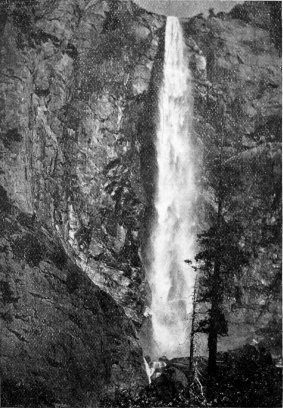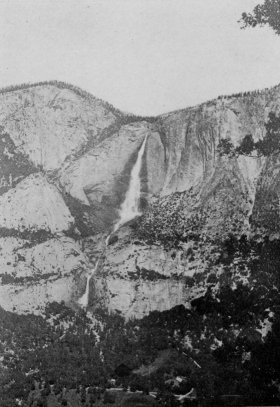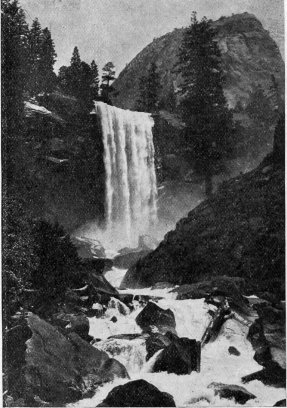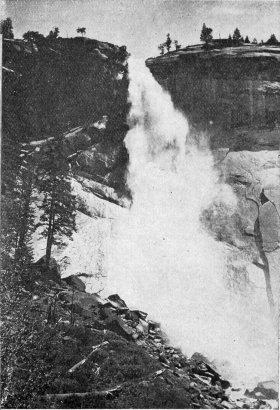
THE BRIDAL VEIL
900 feet
[Photo by George Fiske]
| Online Library: | Title | Author | California | Geology | History | Indians | Muir | Mountaineering | Nature | Management |
Yosemite > Library > Yosemite Valley > Waterfalls >
Next: Mirror Lake • Contents • Previous: Peaks and Domes
THE Bridal Veil Fall, on the south side of the entrance to the Valley, is nine hundred feet in height, and is formed by a creek of the same name, which has its source about fifteen miles to the south in a series of meadows generally known as the Bridal Veil Meadows.
This waterfall is certainly one of the most interesting objects in Yosemite when seen about five o’clock in the afternoon, in the clear sunshine, illuminated by magnificent rainbows.
The upper part of the fall is a perpendicular descent of six hundred feet. It then descends in rapids three hundred feet to the level of the Valley. It has its most charming and fascinating effect when at about two-thirds, of its early spring volume, and when swayed back and forth by the wind, which constantly changes its appearance, there being no two minutes in succession when it looks the same. Late in the season it. becomes a very small stream.
The Ribbon or Virgin’s Tears Fall is thirty-three hundred feet in height and is situated on the opposite side of the Valley from the Bridal Veil.
In the early part of the season it is a very wonderful and interesting waterfall, coming down in a deep recess in the face of the wall twenty-three hundred feet perpendicular to the great pile of talus, then one thousand feet in rapids till it nears its junction with the Merced River.
This waterfall is almost entirely over-looked, or at least little noticed by most visitors, on account of the far superior

THE BRIDAL VEIL 900 feet [Photo by George Fiske] |
The Yosemite Falls, about midway up the Valley on the north side, are perhaps in the early part of the season one of the most conspicuous and interesting features of Yosemite, being in plain view from the hotel, public camps, and business center of the Valley.
They are formed by the Yosemite Creek, which rises on the northwest side of the Mount Hoffman group about fifteen miles northeast of the Valley. Being fed entirely by the melting snow, its volume varies greatly at different times and seasons.
The Falls are in three distinct parts. The lip or edge of the Upper Fall is in round numbers twenty-six hundred feet above the Valley. This lip or edge, through centuries of erosion, has become a narrow circular depression in the smooth polished granite over which the rushing water plunges in a perpendicular descent of sixteen hundred feet, striking on a solid ledge of granite about one-fourth of a mile back from the lower portion of the cliff. From here the wide spreading stream converges into a narrow gorge and plunges in a series of cascades down a descent equal to six hundred feet perpendicular until it reaches the top of the Lower Fall, where it makes a final plunge of four hundred feet to the base of the vertical precipice near the level of the Valley floor. All this can be plainly seen from the Glacier Point trail at Union Point, on the opposite side of the Valley.
The width of the stream at the top of the Upper Fall, at a medium stage of water, is about thirty feet, with a depth of two feet. This widens out towards the bottom to over two hundred feet.
One of the most striking features of this Fall is its swaying motion from one

YOSEMITE FALLS FROM GLACIER POINT TRAIL—Two miles distant [Photo by George Fiske] |
Water in motion does not run in a steady even current, but flows in a series of waves. This is plainly to be seen in the Upper Yosemite Fall, and, as each successive wave descends, its crest separates into small streams which soon vanish in spray. These small streams are commonly called water-rockets. These two peculiar and very interesting features—the swaying and wave motions in the Upper Yosemite and Bridal Veil Falls—are not seen in any of the other falls of less altitude.
In the early part of the season, when the snow on the mountains in the near vicinity of the Valley is melting rapidly, the volume of water in the Upper Yosemite Fall is so great and heavy that it jars the ground a mile distant, frequently coming down with such force and weight as to make a report like distant artillery.
Back of the bottom of this fall there is quite a large cave, which has probably been made by the eroding action of ice in the winter, and it may be possible that the great mass of water, when it strikes the solid ledge in front, causes a concussion of the air in this cave which aids in making these loud reports. During the winter season a large amount of ice accumulates at the foot of the Upper Yosemite Fall. In the cold freezing nights large sheets of ice and great icicles are formed on the face of the vertical walls on each side of the falling water. When the sun shines bright and clear in the day time these great masses of ice loosen and fall to the bottom. The spray is also constantly falling in hail and snow, which forms a
Wonderful ice formations are seen at the base of all the falls in winter.
Sentinel Fall, thirty-two hundred and seventy feet high, is formed by a small stream known as Sentinel Creek, which has its source in the Pot Hole Meadows about four miles distant on the south side of the Valley. This fall comes down in a succession of steep cascades very fine in the early spring, but it is usually dry by the latter part of July.
The Royal Arch Fall has a descent of two thousand feet down a steep incline on the face of the wall. at the western edge of the Royal Arches. It is a fine waterfall early in the season, but is short lived, generally becoming dry in July.
The Illilouette Fall is located between Glacier Point and the Vernal Fall, at the entrance to the upper canyon of the Merced River, above the level of the Valley. It is seen from the trail going to the Vernal and Nevada Falls, and can also be seen, from above, on the trail from Nevada Fall to Glacier Point, which passes close to the top of the Illilouette Fall.
This waterfall never gets entirely dry. It is formed by the Illilouette Creek, which has its source in the Merced group of mountains, a lower part of the High Sierras.
The Vernal Fall is three hundred and fifty feet high, and is one hundred feet wide at the top during the full flood volume,

VERNAL FALL 350 feet [Photo by George Fiske] |
This is one of the most perfect perpendicular water falls in Yosemite. On the south side, at the top, there is a huge slab of granite rock which forms a parapet nearly breast high, over which one may look down the face of the fall and the rapids below. From below we get the finest view from Lady Franklin Rock, and this view is the most interesting at a medium stage of water. A foot trail leads up from Lady Franklin Rock to the top of Vernal Fall. During the hours of sunshine in this locality, when passing through the dense spray near the foot of the fall, a perfect circular rainbow can be seen.
Above the Vernal Fall is the Emerald Pool, deep and placid, where the rushing river seems to stop for a moment of quiet rest before making its graceful plunge over the perpendicular cliff on its rapid course past the Happy Isles to the vale of beauty below.
Next above the Emerald Pool is the Silver Apron, a broad white sheet of water swiftly gliding down the smooth surface of the inclined bed rock at a speed of nearly a mile a minute when the river is at its full spring flow.
Then come the Diamond Cascades, just below the trail bridge, where the whole river bursts with terrific force into scattered fragments from the outlet of the narrow deep smooth granite flume. The river rapids extend above this to the foot of Nevada Fall, forming a rare combination of wonderfully picturesque river scenery.
The Nevada Fall is nearly one mile higher up the Merced River than the Vernal Fall, and is six hundred feet high. Near the top of the fall there is a projecting ledge of rock which throws

NEVADA FALL 600 feet [Photo by George Fiske] |
Next: Mirror Lake • Contents • Previous: Peaks and Domes
| Online Library: | Title | Author | California | Geology | History | Indians | Muir | Mountaineering | Nature | Management |
http://www.yosemite.ca.us/library/the_yosemite_valley/waterfalls.html